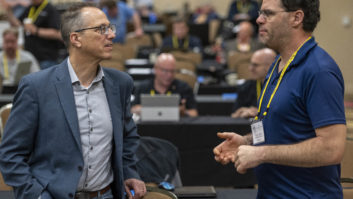The author is technical coordinator, broadcast & media operations for Minnesota Public Radio and American Public Media.
In May, the Minnesota Public Radio | American Public Media TechOps team received the chance of a lifetime: To broadcast the Minnesota Orchestra live from Havana, Cuba! But there were many technical and logistical questions to answer to ensure a successful broadcast.
The biggest obstacle: Transmitting the broadcast off of the island. Were this a domestic broadcast, we’d contract ISDN or AoIP service with the appropriate telephone company and all would be well. Broadcasting from Cuba, however, was not business as usual.

Working the broadcast, from left, are Brian Newhouse, Rob Byers, Brad Althoff and Michael Osborne.
Photo by MPR/Nate Ryan.
We asked our international radio partners (with whose help we could easily secure transmission services in most Western countries) for some advice on broadcasting from Cuba; they simply wished us good luck. They avoid anything of this type due to the difficulty and expense involved. Infrastructure is notoriously lacking, Internet service is practically non-existent compared to U.S. standards, and it is illegal to transport satellite equipment into the country.
A quick look at an online submarine telecommunications cable map (www.submarinecablemap.com/) reinforced the poor connection to the outside world, as most cables bypass the island all together.
Pablo Garcia, veteran broadcast engineer at APM’s Los Angeles bureau, discovered an article in AdWeek about CBS Evening News and anchor Scott Pelley transmitting a live satellite uplink last December when the U.S. and Cuban governments announced that the two countries would begin to normalize relations. That story is interesting on its own, but to us it revealed a path to a transmission solution.
Mr. Pelley’s producer’s Twitter feed led us to clues about the origination of the broadcast: the EuroVision studios at the Habana Libre Hotel. MPR | APM is a member of the European Broadcasting Union, of which EuroVision is the television component, and shortly, we were in touch with the right folks at EuroVision Americas to explore the idea of using their satellite infrastructure. This relationship was key, not only because they provided the technology, but they also handled coordination with the Cuban broadcast authorities. One major hurdle overcome.
ADVANCE WORK
In addition to the live broadcast, MPR News planned to send an arts reporter down to Cuba to report from the field. We needed to file audio multiple times a day for MPR News programs, but for this purpose wanted to avoid the expense associated with multiple satellite uplinks. Colleagues at other organizations warned us that Internet speeds were incredibly slow, unreliable and expensive. We learned that some organizations avoid filing from the island altogether, opting instead to leave with audio in hand and file outside the country.
During an advance trip to Havana in April, I tested a couple of different Internet options, and our intel proved true: All slow and unreliable. A partner organization has ISDN capability, but tests proved that we would need to make some large international hops in order to connect with our headquarters in Minnesota — we were unable to make a direct connection work. It was possible, but would be a pain to coordinate, given our unpredictable filing times.
The final solution came in the form of high-bandwidth satellite Internet service provided by ETECSA, the Telecommunications Company of Cuba. The Minnesota Orchestra and the tour company Classical Movements coordinated this service with all of the media on the trip, and we set up a small press room in the Meliá Cohiba hotel.
That advance trip proved the importance of having good partners in both Classical Movements and the Minnesota Orchestra. Because of our long-standing relationship and the trust between the two organizations (MPR and the Minnesota Orchestra hold one of the longest continuous broadcast partnerships in the country, more than 40 years), the orchestra positioned MPR | APM as the only organization allowed to record the concerts. The Minnesota Orchestra remains one of a handful of major orchestras whose concerts can still be heard on the radio, thanks to the strong partnership between MPR and the orchestra.
The advance trip also helped to establish a positive relationship between MPR | APM and Classical Movements. The tour company was critical in negotiating many of the meetings and decisions needed to coordinate the broadcasts. They also arranged for a direct charter flight from Minneapolis, handled transport of our gear once on the ground, and ensured we were well-fed and taken care of throughout the trip.

The Minnesota Orchestra performs at the Teatro Nacional in Havana. “It was not possible to fly microphones, so all were on stands and positioned to allow for quick stage moves between pieces,” says Rob Byers. “Here the left flank (Neumann KM 143) and the main pair (Schoeps MSTC 64g ORTF) are visible in the foreground, with the woodwind and choral spots in the back.”
Photo by MPR/Nate Ryan.
AUDIO CAPTURE
In addition to the logistics behind transmission, filing, and all of the coordination needed for broadcasting from a remote site like Cuba, we also had to create a high-quality capture of the orchestra.
Though I was able to see the space during the advance visit, the sound of the hall was still a variable. We knew a small amount of amplification would be necessary due to the lack of reverberation in the space, but we had not yet heard an orchestra in the hall. This is where Michael “Ozzie” Osborne, MPR | APM’s technical director for Minnesota Orchestra broadcasts for 15 years, brought expertise.
He knows the sound of the orchestra well and is a trusted face amongst the musicians and staff. Osborne and Terry Tilley, the orchestra’s longtime live audio engineer, now retired, also have a wonderful relationship as they’ve worked together for years, understand each other’s needs and are both trusted by the orchestra.
“Terry wanted to use cardioid microphones where possible so he had plenty of level before feedback,” says Osborne. The only constraint was that anything we took needed to be easily replaceable, as security and humidity were both a concern — in other words, we were not going to take the standard Neumann M50s flanks or the original AKG C24 woodwind spot!
Osborne continues: “We ended up using a Schoeps MSTC 64g ORTF microphone in the center with two Neumann KM143’s for the outriggers. On the woodwinds we used two Neumann KM184’s. We also had a choir so we used four Audio-technica Pro37’s on them. We chose microphones that we knew very well and could be replaced if damaged by humidity or transport.”
The audio console was a Yamaha DM1000. Though it’s an older console by today’s standards everyone on the team knows it well, and it is a flexible workhorse. Osborne is very familiar with the DM1000 since he uses its bigger brother, the DM2000, for the live weekly Minnesota Orchestra broadcasts from Orchestra Hall. We used 16 channels of ATI outboard microphone preamps into an Apogee AD16X analog to digital converter straight into the console. The ATI microphone preamps are extremely good sounding, have very low noise, and they combine eight channels into one rack space.
“Rob discovered on his advance trip that the Teatro Nacional had a fairly short reverb tail when the hall was empty, so I knew I would need to enhance the sound with some reverb, so we used a Bricasti M7, a wonderful-sounding unit,” said Osborne.
Power for the entire broadcast rig ran through the venue’s Furman power conditioners. The staff informed us that the voltage coming in to the building would be fairly consistent during the day but would swing at night, and these units kept that in check. Though power outages are not generally a concern in the city, we brought along a small uninterruptible power supply to backup the key gear just in case.

Conductor Osmo Vänskä
Photo by MPR/Nate Ryan
FIELD WORK
In addition to the wonderful performances from the Minnesota Orchestra, the broadcasts included many interview clips and stereo field recordings from the streets of Havana.
For this, Technical Director Johnny Vince Evans and I took along a Sound Devices 788T recorder with a 722 recording the 2-mix as a backup. We used a Schoeps MK8 and MK41 mid-side pair as well as a Schoeps CMIT 5U shotgun microphone, both rigs in Rycote windshields. We also used the Remote Audio HN7506 headphones when in the field, which allowed us to keep monitoring levels low and protect our ears. We used this robust rig to record the aforementioned interviews, pre-produced voice tracks in a hotel room, audio for video features, and it was put to the test for a four-minute field audio recording feature in the second night’s broadcast.
We knew that supplies would be hard to find in Cuba, so we packed more than the usual allotment of the typical miscellaneous items. Extra batteries, memory cards, power adapters, gaffe tape, even over-the-counter medicines — we packed what we felt comfortable with and then added just a little more. It turned out to be exactly the right balance.
The two broadcasts were a success, and though the logistics and technology are ear-candy to folks who might read an article such as this, it must be said that the real reason for the success were the people involved.
The broadcast and production teams from MPR | APM worked together extremely well, supporting and trusting each other throughout the high-stress trip. The Minnesota Orchestra, its crew and Classical Movements allowed us the flexibility to approach the job how we thought best. And the crew at the Teatro Nacional really went the extra mile, answering our needs large and small.
These broadcasts, historic unto themselves, also contained a bit of unexpected history-making. The second night’s concert began with the Minnesota Orchestra playing the Cuban national anthem, immediately followed by the United States’ national anthem. The audience — including those of us in the broadcast booth — sang along, overcome with emotion as this special moment unfolded before us. We are incredibly proud to have been part of the team responsible for sharing this moment with the rest of the world.
For more, including a video recap, see www.classicalmpr.org/topic/cuba.











